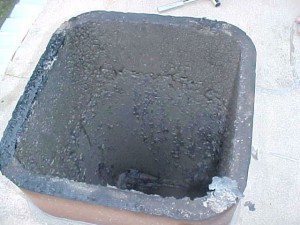Every type of wood-burning appliance experiences creosote buildup. Creosote is a black, tarry substance formed from the incomplete burning of wood, and as it flows up the chimney with the smoke, it cools and clings to the surface of the chimney. This material builds up with every fire, and over time, it can create some serious hazards.
One hazard involves the creosote actually blocking the flow of smoke out of the chimney. The buildup can completely close the chimney up, resulting in a backup of dangerous gases – and creosote – into the house. Dangerous health implications can follow if this is allowed to happen, but luckily this problem can be prevented through regular chimney sweeps and inspections.
Unfortunately, not all creosote issues are so easily resolved. Glazed creosote, also known as level three creosote, is difficult to remove and dangerous. While burning wood always produces creosote, the way the fuel is burned determines the severity and amount of creosote produced. Factors that affect creosote formation include the temperature of the fire, the production of smoke, and the flow of air through the fire. If the fire burns at a relatively low temperature, the result is incomplete burning of the wood, which is the chief cause of glazed creosote. In addition, the glazed creosote can form because of an improperly installed firebox. When the smoke is allowed to cool in the firebox, glazed creosote is often the result, so the ideal temperatures in the flue should stay between 250 and 500 degrees Fahrenheit.
The main hazard of glazed creosote is that it can cause a chimney and house fire. While all creosote is highly flammable, once the glazed creosote begins to burn in the chimney, it is nearly impossible to extinguish. Burning as high as 2000 degrees Fahrenheit, a creosote fire in the chimney can quickly spread to the house, especially since it cannot be easily controlled. The fire can drop embers onto the roof of the house, and the extreme heat can even cause the chimney to explode, resulting in further devastation. For this reason, do not continue to use the fireplace if the chimney sweep has discovered the presence of glazed creosote.
Another unfortunate trait of glazed creosote is how difficult it is to remove. A simple chimney sweep with a wire brush can knock down regular, chalky creosote and leave the chimney as good as new. However, glazed creosote has essentially been baked onto the chimney surface. It often requires the application of an acid over several days to properly remove, and this should only be done by a certified chimney sweep. The hard work involved, usually spread over several days and just as many visits by the chimney sweep, is best left to someone who has seen the issue before.
If you are concerned about glazed creosote in your chimney and want a professional inspection, contact Ace Chimney Sweeps out of Elkton, Maryland to speak with a chimney expert.

